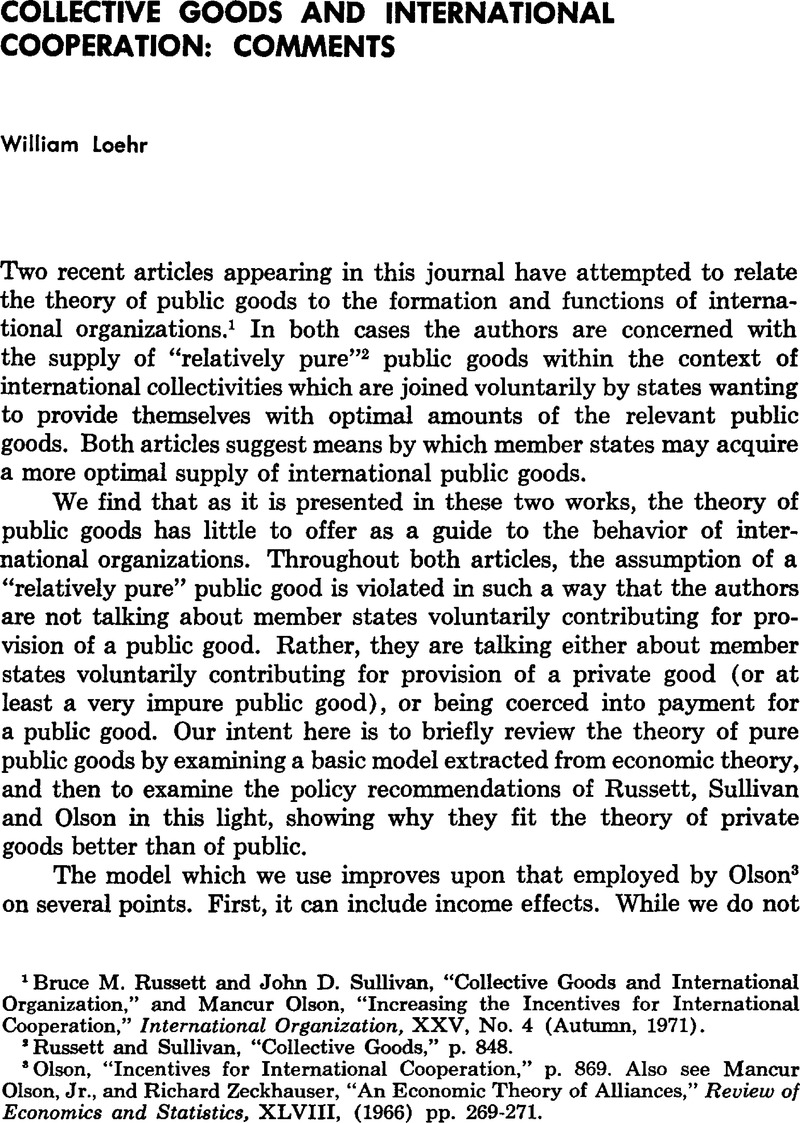Published online by Cambridge University Press: 22 May 2009

1 Bruce M. Russett and John D. Sullivan, “Collective Goods and International Organization,” and Mancur Olson, “Increasing the Incentives for International Cooperation,” International Organization, XXV, No. 4 (Autumn, 1971).Google Scholar
2 Russett, and Sullivan, , “Collective Goods,” p. 848.Google Scholar
3 Olson, , “Incentives for International Cooperation,” p. 869.Google Scholar Also see Olson, Mancur Jr and Zeckhauser, Richard, “An Economic Theory of Alliances,” Review of Economics and Statistics, 48, (1966) pp. 269–271.Google Scholar
4 This exposition follows very closely that of Pauly, Mark V., “Optimality, ‘Public’ Goods and Local Governments: A General Theoretical Analysis,” Journal of Political Economy, 78, No. 3 (05;06, 1970) pp. 572–85.CrossRefGoogle Scholar
5 We have assumed production under constant cost conditions. A modification favoring a more realistic increasing cost situation would add clutter without insight.
6 A's marginal evaluation of both goods is represented by the slope of an indifference curve and the marginal costs by the slope of CA. A's indifference curve (not drawn) passing through P' must have a slope greater than CA. This being the case. A can move from P' along a line representing the rate of transformation of good C into good P. That line is P'P'' parallel to CA. In doing so A can reach ever higher indifference curves (i.e., higher levels of social well–being) up to the Point P'' on the income consumption line, from which point, by definition, no higher level of well–being is accessible.
7 Those not familiar with these conditions can review Buchanan, James M., The Demand and Supply of Public Goods (Chicago: Rand McNally, 1968), pp. 20–22.Google Scholar
8 For a review of the theory behind this see Heller, H. Robert, International Trade: Theory and Empirical Evidence (Englewood Cliffs, N.J.: Prentice-Hall, Inc., 1968), chap. 2.Google Scholar
9 Pauley, “Optimality,” p. 576.
10 In this context a country is “exploited” if its contribution (payment) is greater than its reward for contributing.
11 "Russett and Sullivan, “Collective Goods,” pp. 849, 853; Olson, “Incentives for International Cooperation,” p. 870. See also Russett, Bruce M., What Price Vigilance? (New Haven: Yale University Press, 1970), chap. 4Google Scholar.
12 Olson, “Incentives for International Cooperation,” p. 871.
13 I would like to emphasize that the purpose of the international organization is to increase the supply of the public good to reach optimality. The “cost” referred to here is then the cost to members for the increments.
14 This is recognized by Russett and Sullivan, “Collective Goods,” p. 851.
15 Their strategy no. 3 (ibid., p. 853) is not a strategy but simply states inaccurately what we have already examined above. Number 10 (ibid., p. 858) seems inoperative since it falls back on the proportionality idea “provided that the amounts in question are not large enough to make evasion worthwhile.” This implies that proportionality might work, but only on minor issues.
16 Ibid., p. 852.